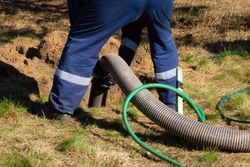
Septic systems are particularly popular in rural areas, where sewage systems and sewer mains are often absent. They can handle homeowners’ waste treatment needs without relying on municipal resources. However, you need septic tank pumping services for your system to work properly. Here’s what you need to know about the process.
How Does Septic Tank Pumping Work?
When your septic tank and drain field are working properly, it’ll break down any septage. However, scum and sludge will inevitably build up in your system over time. When that happens, you’ll need to have a professional pump out the waste. Otherwise, the system could overflow, causing toilets and drains to leak waste.
 A professional will essentially remove the effluent and sludge, making sure the tank is empty. Once they’ve pumped the waste into their truck, they’ll take it to a waste treatment plant. In the past, they would bury the sludge, which is no longer legal, as it’s considered a health hazard.
A professional will essentially remove the effluent and sludge, making sure the tank is empty. Once they’ve pumped the waste into their truck, they’ll take it to a waste treatment plant. In the past, they would bury the sludge, which is no longer legal, as it’s considered a health hazard.
How Often Should You Get Your Septic Tank Pumped?
If the bottom of the floating scum layer is within half a foot of the outlet pipe, it’s time to call a septic tank pumping professional. This generally happens every one to three years. To avoid problems with backups or overflowing, have the system checked at least once a year.
Some common signs that it’s time for pumping services include frequent toilet clogs, unpleasant and abnormal odors, or a pool of water forming over the tank lid. Finally, newer septic tanks often have alert systems that will let you know when it’s time.
When you need septic tank services, contact Wright's Septic Service. Serving Monroe County, WI, they have over 50 years of experience working with homeowners in the area. In addition to providing pumping services, their professionals will inspect your system for problems and help maintain it. This locally owned business prides itself on friendly customer service, excellent communication, and expertise in the industry. Call (608) 372-3615 to schedule an appointment, or visit the website to learn more.
About the Business


